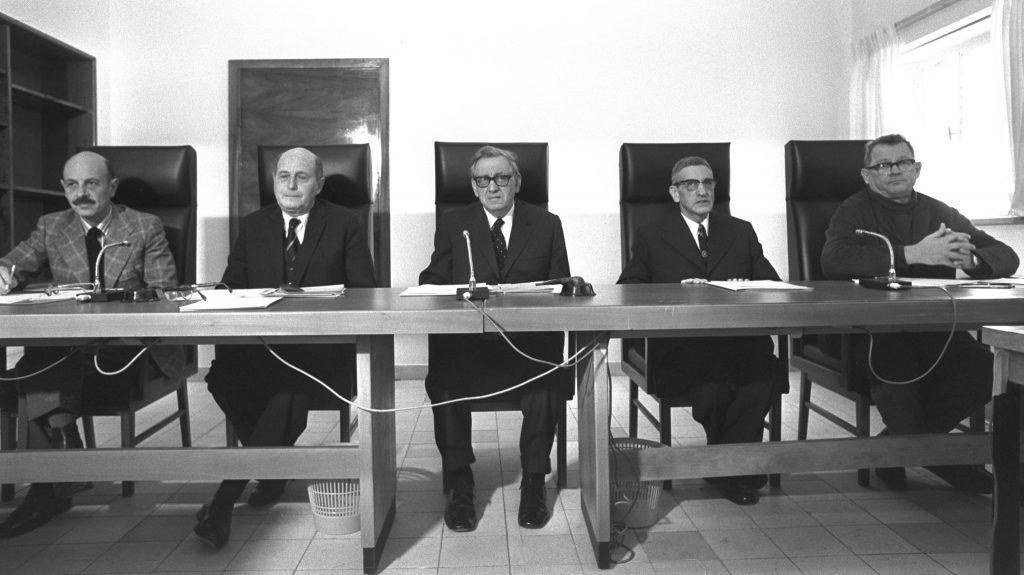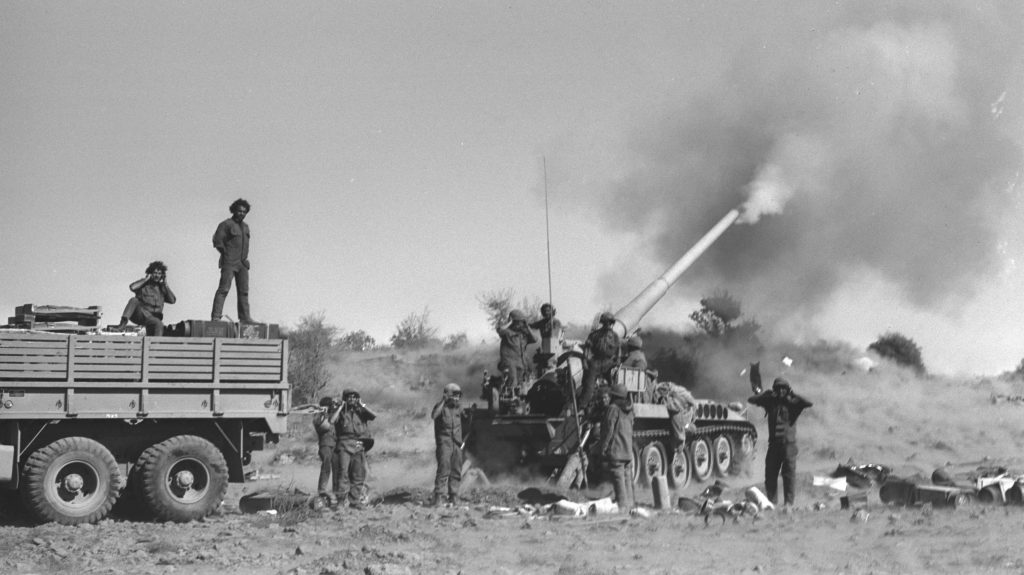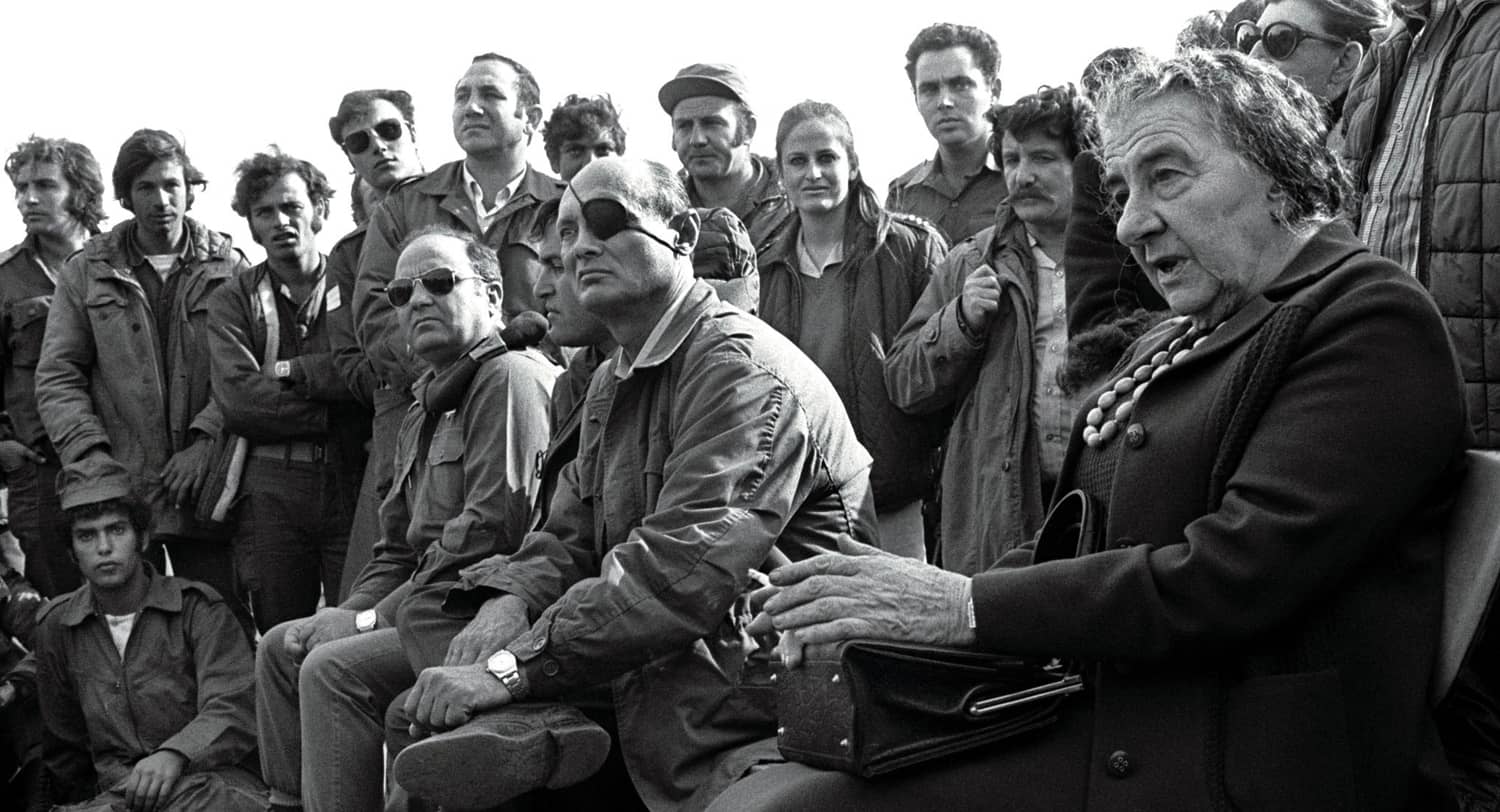With the approach of the 50th anniversary of the Yom Kippur War of October 1973, it’s time to revisit one of its ongoing scandals in Israel, the claim that the government’s surprise at the start of the war was caused by a set of assumptions, based on intelligence assessments, called in Hebrew the “konzepzia.”
>> Inside Intelligence: Read more from Amir Oren
This term konzepzia is a Hebraized import from the Eastern European languages of Israel’s founders. It literally means “an interrelated set of working assumptions on a specific topic.” In Israel, the term acquired the pejorative sense of “groupthink” (first used in this way to describe the faulty security plan in the 1972 Munich Olympics massacre of Israeli athletes). Today no Israeli in his right mind, least of all in the intelligence industry, dares embrace the term, although working assumptions are necessary in planning operations.
The notion that an intelligence konzepzia was responsible for Israel’s surprise in the Yom Kippur War of October 1973 originated with the five members of the Agranat Commission of Inquiry.
Prime Minister Golda Meir set up the Agranat Commission several weeks after the war ended on the Egyptian front (though the war continued as low-level attrition combat for an additional seven months on the Syrian front) and six weeks before a general election was to be held. She hoped that the public would trust the Agranauts to issue a fair appraisal of the various actors and agencies accountable for the shocking under-performance of the vaunted defense establishment.
The terms of reference for the inquiry were conveniently – for Meir – limited to the run-up to the war and its first three days, marking both the end of the Egyptian advance into Sinai and the failure of the initial IDF Southern Command counter-offensive. While members of the political echelon were not specifically outside the Commission’s purview, they were spared and instead the Commission focused on career military and intel officers. It is for the public to pass judgment on elected officials through elections, the Commission members would later say – but their report wasn’t available when voters went to the polls on December 31, 1973. The Agranat Commission issued its report three months later, well after Meir had formed her third cabinet in four years.
A gaping omission in the inquiry had to do with diplomacy and strategy. Meir’s platform of war and peace, her secret contacts with the Nixon administration, the impact of domestic politics on defense priorities – all of that remained in the background, as the Commissioners raced to crucify the generals and intelligence chiefs. Years on, some of the Agranauts admitted as much, saying that stabilizing the Meir government was crucial for an Israel engulfed in self-doubt and recriminations.

Who were five members of the Agranat Commission? The Agranat Five were the epitome of the Israeli establishment, though they had zero political experience, which may partly explain their naïveté. Shimon Agranat was the Kentucky-born Chief Justice of Israel’s Supreme Court. His Supreme Court colleague, Moshe Landau, was in line for the chief justice job based on seniority. The State Comptroller, Yitzhak Nevenzal, was an efficient book-keeper, presumably able like the jurists to establish facts and assign responsibility and culpability.
And then there were the two retired lieutenant-generals (Israel’s highest military rank). Yigael Yadin and Haim Laskov had both led the Israel Defence Forces in the 1950’s and apparently got stuck there. They were respected but outdated, their military knowledge as relevant to 1973 as was the British Army of 1943 and the Haganah irregular force of 1948. But in the Israeli public a former Chief of Staff was as revered a figure as you could get. Only decades later was it revealed that hours before he agreed to serve on the Commission, Yadin had checked with Meir’s confidants to see whether she would appoint him to be a cabinet minister.
Conflict of interest aside, Agranat and company had to base their anti-intelligence attitude on valid-sounding charges. Thus, the konzepzia. Allegedly, the boneheaded intelligence officers dogmatically stuck to their bias, regardless of the warning signs that reality was much more complicated and demanded caution, not complacency.
The Commission’s first fault was in focusing on an intelligence konzepzia as the reason for the initial failure in the war. Documents from that era show it to be false.
Once Egypt and Syria had attacked, the term-du-jour became “The Scenario” – a diplomatic plan demanded by Meir and agreed to by newly-installed Secretary of State Henry Kissinger. The Scenario’s premise was that Israel would quickly block the invading forces on both fronts and then move to counteroffensive and gain new ground across the violated ceasefire lines. Sadat and Assad, indeed the entire world, would learn that Israel punishes those who dare attack it. The American role in the Scenario was to stall all efforts in the UN Security Council to adopt ceasefire resolutions freezing the front lines, until the invasions were repelled.
The Scenario was shattered by reality. Israel failed to meet its own military expectations. Less than a week after the war started, the Israel Air Force lost so many planes and pilots that its chief pleaded for an immediate ceasefire in order to recover and regroup. Kissinger was stunned to hear about Meir’s about face. He deflected the UN diplomacy to the British and from them to the Australians, only to hear that the Arabs – who earlier had been content with keeping their initial successes and calling it quits – now insisted on prolonging the war. The Agranat Commission was neither aware of nor interested in any of this, though the cost in subsequent Israeli casualties was enormous.
By whatever name, either konzepzia or The Scenario, people and governments must proceed according to some plans and assumptions following their assessment of the situation. A choice must be made between alternatives. It may turn out to be wrong and “the road not taken” to be right, but the reality of flexible working assumptions – not groupthink or dogma – is natural and commonplace.

So what was so terrible about the konzepzia of the intelligence agencies as presented to the Israeli public in the Agranat report? Let’s review the situation leading up to the Yom Kippur War of 1973.
The Six-Day War of 1967 ended in a UN-mandated ceasefire along the lines reached by the conquering Israeli forces. But the losing parties – Egypt, Syria and Jordan – never agreed to the occupied territories being kept by Israel. They vowed to liberate them by whatever means necessary. For the following six years, Israel was on notice that full-scale renewed hostilities could be averted only by diplomacy and deterrence.
This was not peace. It was not even an armistice, but merely a lower level of violence, consisting of exchanges of fire across the Suez Canal with Israel’s main enemy, Egypt. This War of Attrition ended in early August 1970 when Egypt’s Soviet surface-to-air missiles foiled sorties of Israel’s US F-4 planes and Meir had to accept a diplomatic blueprint. When summer turned to autumn, war could have very well resumed if Nasser had so chosen.
It was not to be, because the ailing Nasser died in late September 1970. Egypt focused on the transition of Vice President Sadat, who had to consolidate his grip on power against a Soviet-backed rival. The renewed war against Israel could wait for a more opportune time. There was no rush.
Meanwhile, in Damascus, another transition took place. Defense Minister Hafiz al-Assad led a coup and became Syria’s ruler, launching a dynasty still in power 53 years later. Assad, too, was cautious. He vowed to liberate the Golan Heights, one way or the other, but not just now.
Throughout the early 1970s, Israel had good – not perfect – intelligence on relatively open Egypt and not-so-good on police-state Syria. Jordanian Intelligence had recruited a senior Syrian Army commander, probably a brigadier-general, who was privy to contingency planning and military deployments, but not to Assad’s calculations. King Hussein, grateful to Israel for rescuing him from a Syrian-backed attempted Palestinian coup in September 1970, shared this information with the Mossad, CIA and with Meir personally.
This Jordanian source was partly told by Sadat and Assad that they intended to wage war on Israel.They suspected he had secret channels to both Washington and Jerusalem, and kept the most crucial detail, their D-Day, to themselves. When he met Meir at a Mossad facility 12 days before the war, in September 1973, this source was not – and could not have been – aware of their decision to launch simultaneous attacks on October 6. The Egyptian and Syrian General Staffs only ratified this tentative plan on October 3.
In addition, Israel had insights into Sadat’s mind thanks to its source, Nasser’s son-in-law Ashraf Marwan. But it had no inner circle equivalent close to Assad. Israeli intelligence collected a lot of material on doctrine, disposition, training and operational planning, but was in the dark regarding precise intentions.
The konzepzia, as cited by Agranat, posited that Egypt would not go to war without Syria (and vice versa). Without a second front, the full thrust of Israel’s air force and armored divisions would concentrate on one inferior Arab belligerent. Furthermore, the belief was that Syria was in a no-go framework.

As for Egypt, the konzepzia assumed Sadat would not dare attack in the Suez Canal area – either by artillery, commando raids or full-fledged invasion – as long as the Israel air force had total dominance over Egyptian air space, enabling it to attack at will targets in Cairo and other hinterland regions. What Sadat needed, so the thinking went, was to neutralize this dominance through a counter-deterrent, a weapon capable of penetrating Israel’s air defense and hitting its population centers. Only once he had such a weapon could Israel be expected to choose mutual restraint on both home fronts and limit the conflict to Sinai.
In turn, this limited campaign in Sinai would suffice to bring about Sadat’s strategic goal of breaking Israel’s myth of military invulnerability, restoring Egyptian pride and paving the way to peace talks, in the process moving Cairo into Washington’s political and economic orbit.
This paradigm was not the speculative product of an analytical process at the headquarters of the Directorate of Military Intelligence (Hebrew acronym is AMAN) or the Air Force Intelligence Group (named Machman, later changed to Lamdan), though it was validated by analysts in both places. It was the real thing, an intelligence gem, pilfered by Marwan out of discussions and documents. All the Israelis had to do was to check the text against actual delivery.
This is where they failed. The konzepzia was not a museum piece. It was fluid, dynamic, requiring constant updates. The Israelis knew Sadat wanted more strike aircraft as the counter-deterrent weapon. Those he got on loan from Libya were not enough and came with strings attached. The Soviets were in no hurry to supply the sophisticated Sukhoi planes. Reinforcements were thus expected only in the 1974-75 time frame. So far, so good for the konzepzia.
But there were two problems not fully accounted for – surface-to-surface SCUD missiles and the fact that Sadat, if desperate enough, could reach a decision to go to war even before his arsenal was adequately stocked.
Various elements within the intelligence community were locked in an argument about the SCUDs – have they been shipped, are they controlled by the Soviet instructors accompanying them, what will the rules of engagement be once they are declared operational? Differing views were debated and weighed. Finally, a higher probability was assigned to the SCUDs not being available to the Egyptian military just now.
That turned out to have been wrong. SCUDs had been in Egypt since early summer 1973 and were cited publicly by Sadat during the war to warn Israel against striking his cities. But it is the height of simplicity to ascribe to this factual error Meir’s momentous mistake in downplaying the risk of refusing to moderate her diplomacy strategy.
Strategically, Sadat’s decision to go to war was no secret. He ceaselessly declared, warned, threatened that if pushed to the wall he will order it, regardless of cost and consequences. In addition to public speeches, he sent messages via visitors who traveled from Cairo to Jerusalem. Meir was unmoved. Meeting Nixon and Kissinger on March 1, 1973, the most she would concede in an eventual agreement with Egypt was to redeploy a few dozen kilometers east of the Suez Canal. But Sadat did not care about the distance as long as an eventual full withdrawal from the Canal was guaranteed. Rather than negotiate that, Meir presided over a Labor Party platform which vowed to permanently hold onto the eastern third of Sinai.
Sadat’s plan required initial Egyptian gains, though Israel could then be expected to recover and throw its might at the invaders – if the war would not be stopped diplomatically, by either the UN or mutually acceptable mediators like the Shah of Iran (yes, it was a different Iran in those days) and Kissinger.
For the initial gains, Sadat needed operational surprise. Israel had only one army division in Sinai, against five in the invading force. Mobilizing reserves and driving them over 250 kilometers from the country’s center to the Canal would take time, while the air force would be torn between the two fronts. Secrecy must be maintained, hopefully helped by deception, but if the Israelis get word of the imminent attack and mobilize, no harm done – he could abort, ridicule the Israelis as panic-prone, wait for another opportunity and then generate global pressure for a peaceful resolution through the specter of a crisis or two (oil embargo, superpower confrontation).
Thirty-six hours before the Yom Kippur War started, the Israeli leadership – Defense Minister Dayan, Chief of Staff Elazar, and later that day Meir and several cabinet colleagues – did away with the intelligence assessments. They did not know for a fact that war was a mere day and a half away, but they suspected that it could be and adopted that suspicion as their working assumption, overriding the intelligence assessment of a “low probability” guesstimate.
The national leadership chose a mix of maximum diplomacy – asking the US to plead with the Arabs and the Soviets to de-escalate – and minimum deployment. The standing force was to put on full alert (it wasn’t) but to avoid any movement to the front. Reserves were not to be called up. ”The regulars will block” was the motto.
This, then, was the real konzepzia, having to do not with an assessment of Sadat’s probable moves, but of their outcome should he show such chutzpah as to provoke the IDF to hit back.
In the halcyon days of summer 1973, the Meir government and the IDF General Staff believed Israel could keep the 1967-won territories and even enlarge them if attacked (hence, only offensive plans west of Suez). This illusion of omnipotence had a component of omniscience, based on AMAN and Mossad assessments, but this was the minor konzepzia, undeserving of the opprobrium heaped on it by the Agranat Commission.
In sum, at the heart of Israel’s initial failure in the Yom Kippur War was a form of groupthink. But it was about the ability of Israel’s standing army to repel a joint attack regardless of the circumstances and a corresponding lack of urgency in negotiating territorial concessions. It was more of a political konzepzia rather than a purely intelligence one, despite the allegations of the Agranat Commission.
In April 1974, Golda Meir resigned from office in the aftershock of the Agranat Report’s release. The Israeli public had refused to narrow the blame for the konzepzia to the career ranks.



